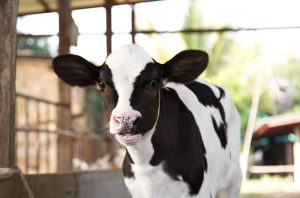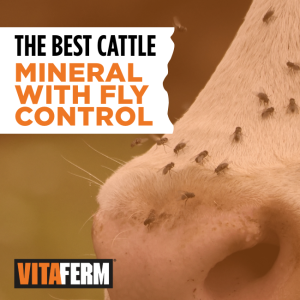
Spring has arrived and soon cattle producers will be thinking about turning their cattle out on nice green pastures. Spring grazing is always an exciting time, but before you turn out those pairs to green grass, consider a hidden concern of grazing.
Grass tetany can be a challenge for producers during spring and early summer grazing when there is an excess of potassium in their forage. Fortunately, with proper management and care grass tetany can be prevented, according to Kevin Glaubius, Nebraska Area Sales Manager at BioZyme® Inc.

Grass tetany is also called grass staggers because when cattle become susceptible, they start to stagger around and will go down on their side. One of the first symptoms is general lack of coordination.
“Most producers think of tetany as a magnesium deficiency because feed companies use magnesium to prevent occurrence, but really it is excessive intake of potassium. Potassium and magnesium compete for the same absorption pathway,” Glaubius said. “Think of the absorption pathway like a funnel where three potassium marbles are trying to get through the funnel the same time as one magnesium marble. Since the percentage of potassium marbles is greater, that nutrient is more likely to go down the funnel and get absorbed before the magnesium does.”
Tetany typically occurs in older animals rather than younger animals because of an inability to mobilize the magnesium from the bones. Mature cows will show signs long before a young calf.
Most of the time tetany will happen when cattle are on lush forages. While transitioning from winter to spring, nutrients, including potassium, are being pumped up from ground through the roots to support plant growth. When there are a few weeks of warm weather, those nutrients get pumped up to the plant that is above ground, actively growing. But if a cold snap or cool weather sets in, growth pauses, but those nutrients continue to accumulate in the plant. With those warm weather/cold weather cycles, the potassium levels can potentially become twice the amount they normally are, leading to tetany challenges when you turn your cows out this spring.
Since tetany is a nutritional issue, it isn’t isolated to just the spring and summer when we turn cattle out to grass; It can also happen while feeding hay. In that case, we have what might be referred to as “winter tetany” or “wheat pasture poisoning” when cattle are fed harvested winter feeds that are high in potassium. In that case, you should have your forages tested.
Most of the country doesn’t have problems with tetany in the fall. However, it can be an issue especially if producers fall fertilize. Tetany is a global issue and impacts all ruminants who have an improper potassium to magnesium ratio.

“We are very susceptible to grass tetany in this area, but we’ve had zero issues with it. We feed VitaFerm® Concept•Aid® Mag 5/S, and in this area, I feel producers need to feed Concept•Aid with high mag year-round.” -Charlie Boyd II

There is no perfect mineral for preventing grass tetany; however, feeding a high-mag mineral during the high-risk periods such as spring and fall when the growing season can easily be disrupted will prevent the vast majority of issues. The first mineral that Glaubius recommends for cattle producers with high-potassium forages is VitaFerm® Concept•Aid® Mag/S. Start increasing magnesium levels about two weeks before turning out to pasture so you can gauge how much the cow might eat when she is turned out on grass. Remove all other sources of salt so that forces the cows to get salt from the mineral if the bitterness of higher magnesium restricts intake to less than the recommended amounts. Or, you might have to force-feed the magnesium in a grain mixture if the cows won’t eat the free-choice mineral.
When a high-magnesium mineral doesn’t work, a second possible option for prevention is dilution.
“Why is it sometimes that high-mag mineral fails? With any free-choice mineral, especially with an ingredient like magnesium that is bitter, you might not be able to get a cow to eat enough mineral to fix the ratio. If the potassium is in excessive levels, lock them away from lush forages and offer them a bale of grass hay in a lot. Restrict their forage consumption to four to six hours per day in order to dilute intake of high potassium forage,” Glaubius said.
Remember to check your cattle regularly when they are first turned out to new, green grass. Grass tetany is treatable if it is detected early. Call your veterinarian at the first signs of any tetany. The vet will typically provide an intravenous solution of calcium, magnesium and glucose to get the cow back on her feet. Timing is critical though, as cows will likely die if not treated within 4-8 hours after onset.

Although grass tetany doesn’t happen in every part of the country or every year, if you are a cow-calf producer who has ever dealt with tetany or excess potassium, it is a good investment to plan ahead with a high-mag mineral program. In fact, two producers in the same county could have forages with different results in any given year.
“Potassium in large amounts is deadly, so tetany does have a big impact. That is why magnesium for someone who has lost an animal in the past becomes like an insurance policy,” Glaubius said.
The VitaFerm Concept•Aid Mag/S compared to VitaFerm Concept•Aid 5/S is about two cents more per day to feed. And, a producer will typically only feed increased amounts of magnesium for 60 days, so for $1.20 per cow annually – less than a large iced tea at McDonald’s – you can provide your cows with the added nutrition they need to help prevent grass tetany.
“If you save one cow from grass tetany every four years, it is a break even to feed it to a herd of 100 cows every year. Considering it costs roughly $1,200-$1,500 to replace a cow, and her calf could bring anywhere from $700-$800 at weaning, that’s a pretty good investment in her health,” Glaubius said.
As with all health challenges, the key to preventing tetany is to provide the proper amounts of all nutrients. If you can keep your magnesium to potassium ratio in check, your cows should enjoy grazing green grass and keep healthy. BioZyme offers several supplements in its VitaFerm product line that are enhanced with magnesium to help prevent the onset of tetany including VitaFerm Concept•Aid Mag/S and VitaFerm Cow-Calf Mag Mineral.


